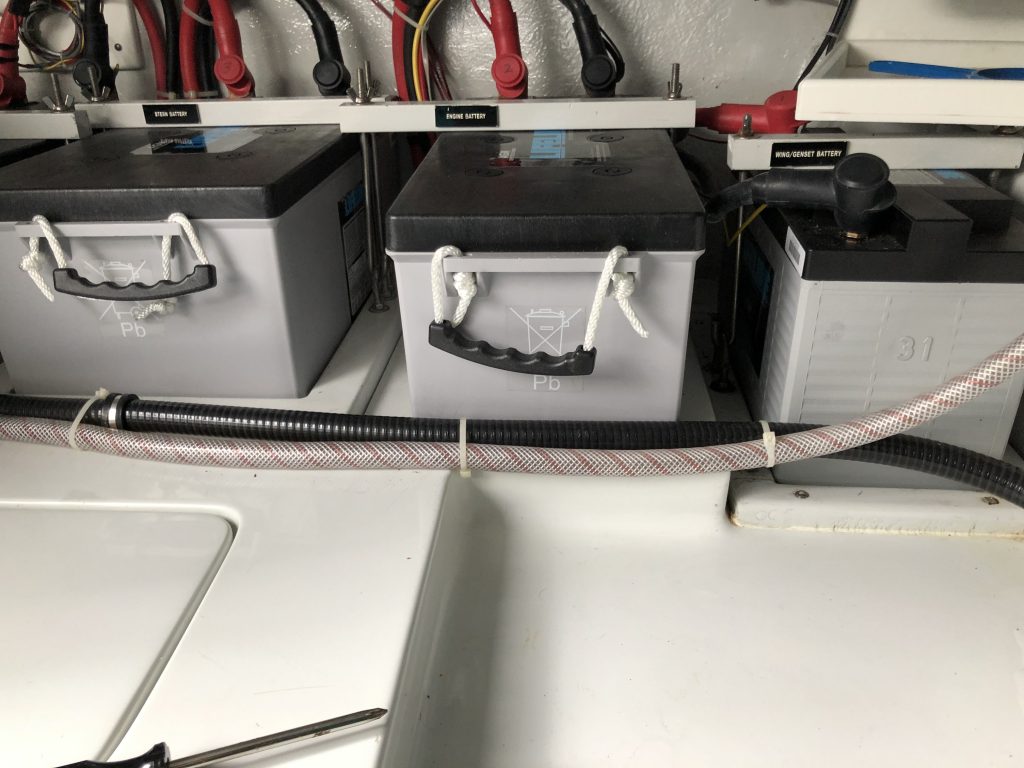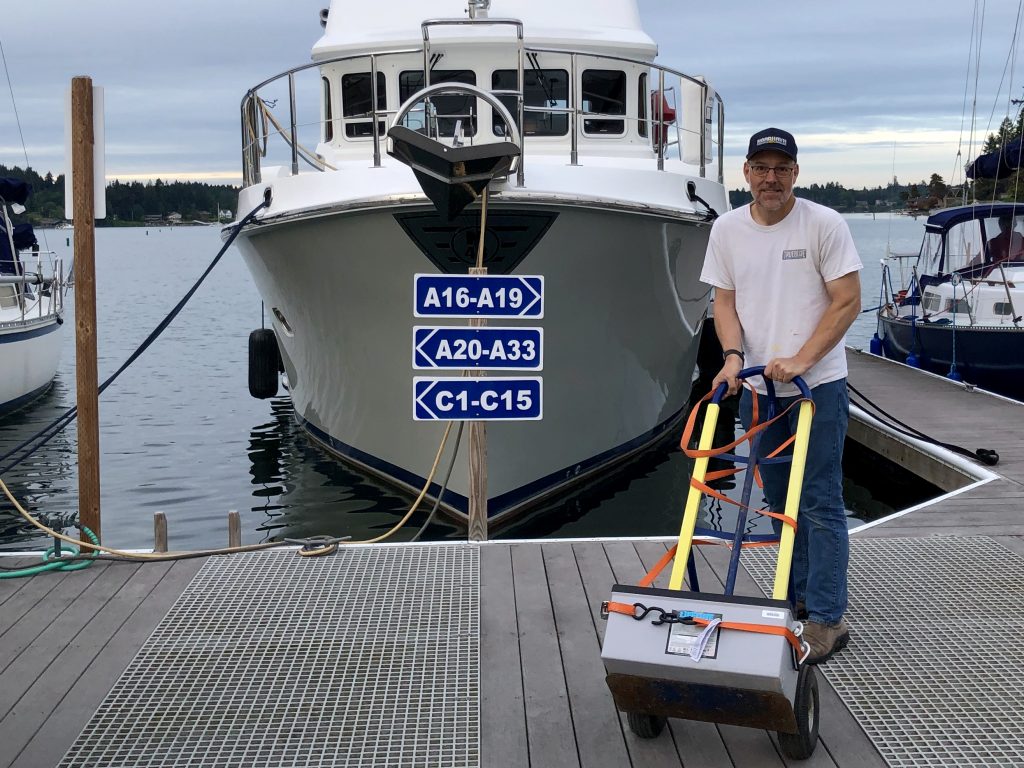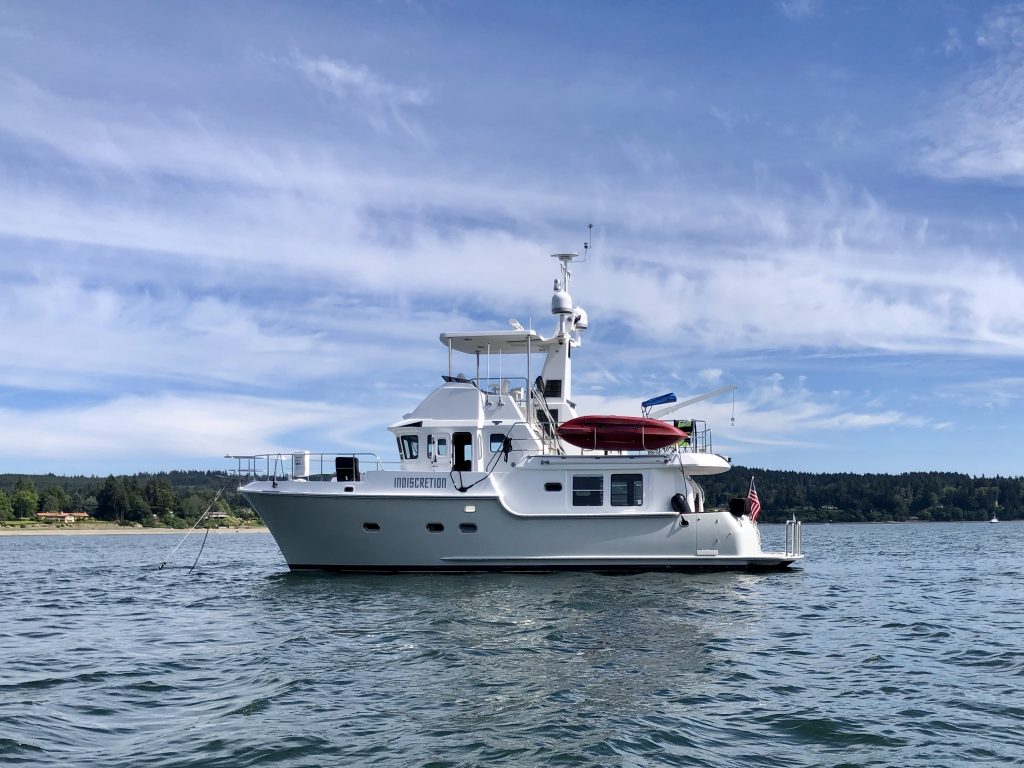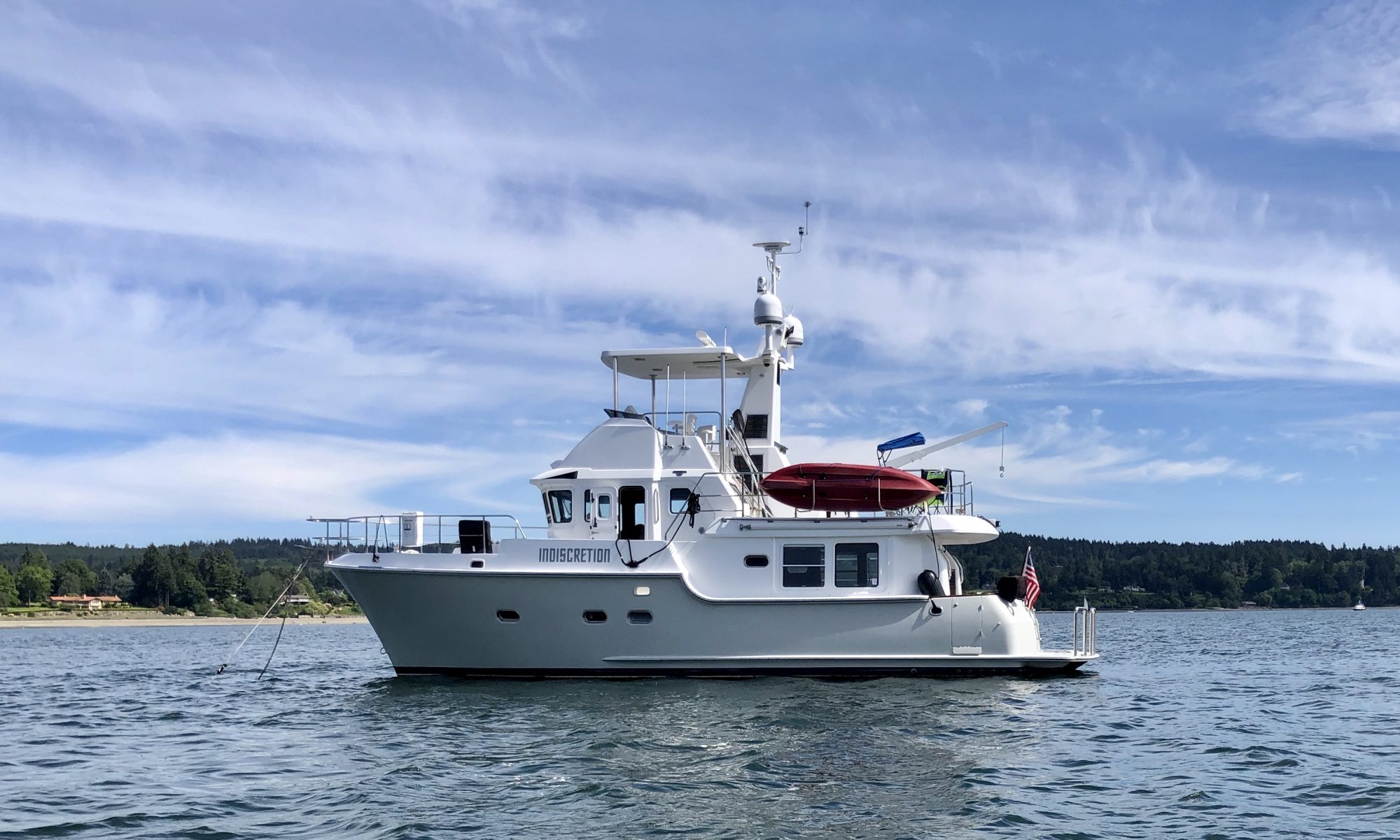Over the past few months, we’ve been awakened by our Maretron monitoring system with a low-battery alarm during the wee hours. You cannot distinguish the low-battery alarm from the Anchor watch alarm, so on the times this has happened, I immediately launched myself to the pilothouse to gauge which way we’re dragging, peering out of the dark windows for some sign of a lee shore. Once fully awake, I noted that the battery level was perilously low.
While there are lots of power-draining systems on the boat, the main culprits are the freezer and refrigeration units, which make up more than 70% of our typical amperage use.
Indiscretion has four Lifeline 8D batteries to power the house, which were over five years old, and was having a hell of a time keeping a charge. Our generator run times had grown from two hours, twice a day, to eight hours, four times a day. And even that wouldn’t allow us to make it through the night without running low. Our ability to anchor out for more than a day was severely compromised. Not the kind of thing you expect from an expedition trawler.
One way to potentially breathe new life into older batteries is to run an equalization process through the inverting/charging system. Equalization is a controlled overcharging of a fully charged battery. This overcharge mixes the electrolyte, evens the charge among varying battery cells, and reduces permanent sulfation of the battery plates. Our Xantrex inverter has this function, but we saw no improvement in performance after equalizing the battery bank.
So, it was time to replace the batteries. Besides the four house batteries, we have a Lifeline 4D battery to start the main engine, and two smaller Lifelines to power the generator, wing engine, and an isolated communication battery for emergencies.
We got a bid to have all seven batteries replaced by during our upcoming haul out, but the price tag surprised us. All told, we were looking at $7,500 installed, and we would have to wait at least two months until business got back to normal with COVID-19.
We searched online and soon found that Batteryguys.com would deliver these same batteries to our door for $4,300. I contacted Lifeline to ask about this online vendor. I was concerned that I would be getting old or refurbished batteries but was informed that Batteryguys was one of Lifeline’s largest customers, and they ship out pallet loads of batteries to them every week. We could buy these with confidence.
A nine hundred pound pallet showed up ten days after we placed our order.
Installing the Batteries
Now, we faced the hard part of removing the old batteries and installing the new ones. These batteries are heavy! A Lifeline 8D battery weighs a whopping 156 pounds, and we had four of these beasts to finagle in tight places.
On Indiscretion, five of the batteries are stowed in the stern, deep inside the lazarette, with a limited wiggle room to work. All the batteries fit inside custom battery trays and are secured with stout hardware to keep them in place, even if we capsize.

I recruited my 18-year-old son Connor to help me with the project, and he was a huge help. Not only does he now seem as strong as me, but he also had some great ideas during the long day of ways to make the arduous process easier.
Our first mission was removing the old batteries. Before messing with battery terminals, we switched off all the battery switches, unplugged from shower power, and turned off the inverter. The boat became eerily silent without the ever-present hum of transformers and refrigeration.
We started with the group in the lazarette. The first two in the line were easy to access and the lightest of the bunch. We removed the tie-down hardware and disconnected the battery terminals. Out came the Lifeline 31XT used by the wing engine and generator. At a mere 74 pounds, it gave itself up without much fight. Its next-door neighbor, a 124-pound Lifeline 4D that starts the main engine, slid straight out. These batteries have rope handles to make lifting them less awkward. We tied an eight-foot loop of stout rope to each handle of the 4D to lift the battery out of the lazarette into the cockpit. I grasped the rope from inside the lazarette, and Connor lifted from the cockpit above. Up and out, the battery went. Once in the cockpit, we worked together using the lifting rope to work our way to the cockpit door and over the 18” chasm between boat and dock.

Next was a line of three Lifeline 8D batteries, deep inside the lazarette. Each sat inside a recessed enclosure and would need to be lifted out of the enclosure, pulled forward, rotated 90 degrees, and slid out. Lifting a 156-pound battery in an enclosed space without headroom is hard. We worked together to pull the battery up on one edge of the enclosure, only to have it become wedged or fall back inside its box as we jiggered it. Eventually, we discovered applying a lever to pry up the battery worked well. We used a long wrench and the wooden handle of a hammer as levers. With this new leverage, we managed to extricate two of these beasts and haul them onto the dock, leaving just one remaining 8D battery nestled on the other side of the rudder post. For this one, Connor contorted his thinner frame over the hot water tank on the starboard side, and I wedged myself from the port side, laying where the previous four batteries once sat. Levers, sweat, and some cursing eventually led to the successful extraction of this last lazarette battery.
The communication battery in the pilothouse was simple to remove. We used brute strength to lift and hoist the 8D battery under the floorboards in the guest stateroom out of its hole, and up and down the pilothouse stairs, one step at a time. Did I mention these 8D batteries were heavy?
We used a hand truck to haul the new batteries from the back of my truck in the marina parking lot down the long dock to the boat. One by one, we hauled the new batteries aboard and began installing them. We had been working about three hours by this point and were plenty tired, but it felt a little easier to get each one put in place. Plopping a battery into its retaining box is a lot easier than trying to extract one out. Another two hours of battery wrangling, and we finished the installation. We turned on all the battery switches and shore power and watched the boat come back to life. The new batteries were taking a charge from our inverter, and everything worked as we expected.
Hauling the old batteries away was our final task. We waited until the evening high tide when the ramp to the parking lot was near level and hoisted each battery into the bed of my truck. I sold these old batteries to a salvage yard in Tacoma for about $100.

All told, it took us six hours of labor to remove and install the batteries. Connor seemed unfazed from the work. Ah, the joys of youth. I definitely needed a soak in the hot tub that night.
Testing Out the New Batteries
A few days after we completed the battery installation, we decided to take advantage of the lovely June weather here in the Pacific Northwest and spend a few days on the hook to test things out. Our chosen anchorage was a mere mile from our marina: Inner Quartermaster Harbor.
We had the anchor set around noon. We tracked the battery levels throughout the day. They seemed to be holding up fine. At 8 pm, we ran the generator for an hour and were able to bring the battery level up nearly to 100%.
At 7 am the next morning, I was pleased to see our battery level hadn’t reduced much. The voltage at the panel read 12.7. Our Maretron battery percentage showed a respectable 80%. We ran the generator for an hour to top off the batteries while we made coffee and showered. By the end of the hour, we were closing on a 95% battery charge.

Restoring our battery capacity and recharging capacity took some physical effort and a hefty price tag. Still, the benefit of staying out on anchor for days (or weeks) on end is worth it.
Fair winds!


Wouldn’t be lithium batteries a much better choice? Much lighter and with longer lifespan. More expensive to buy but cheaper in the long run.
Hi Marc – We considered going with lithium batteries. We know a few other boats with these batteries and love them. I decided to stick with Lifelines for a couple reasons. First, it was a simple (if heavy!) swap out with no modifications needed for the battery boxes, charging system, etc. Second, we’re planning on visiting some pretty remote places in our travels and if had a battery failure, we wanted to make sure we could source new ones locally. Lithium style batteries are still pretty new technology and we heard from others that support could be hard to find in remote places. All that aside, we’ll definitely be going that way next time we need a battery replacement. Thanks for your question!